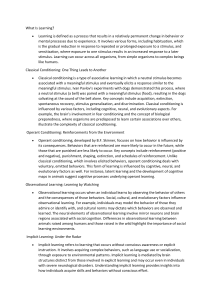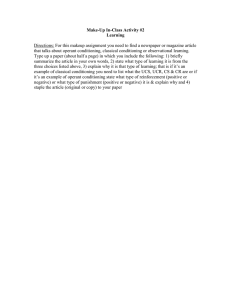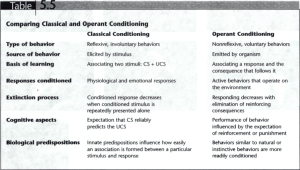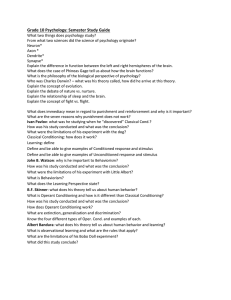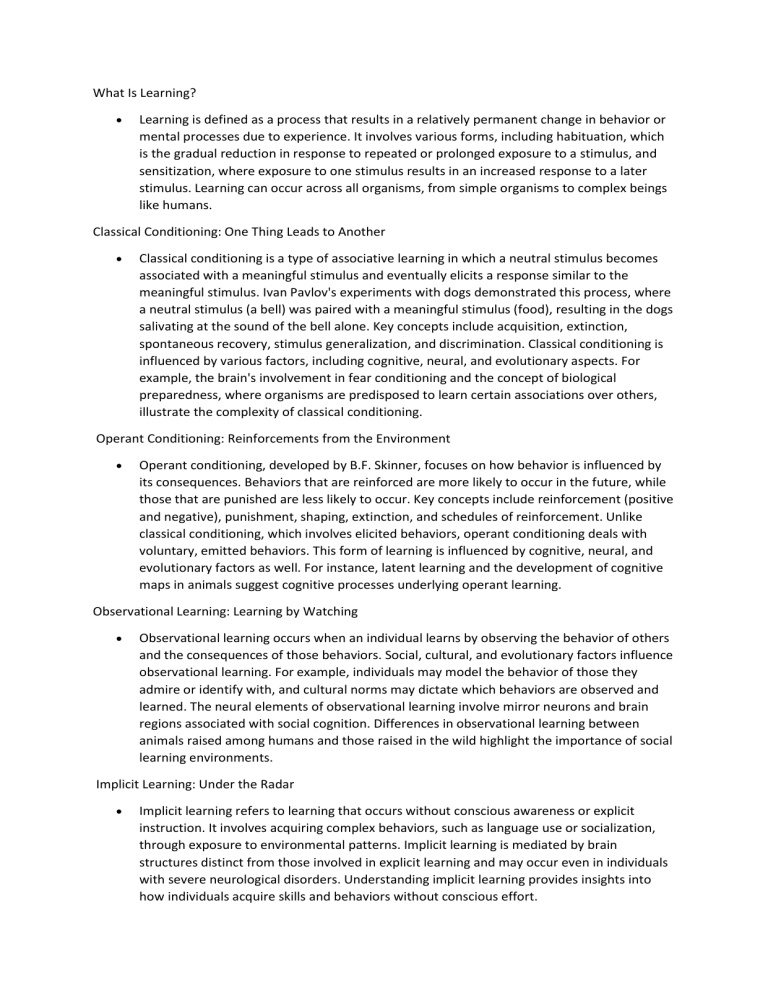
What Is Learning? Learning is defined as a process that results in a relatively permanent change in behavior or mental processes due to experience. It involves various forms, including habituation, which is the gradual reduction in response to repeated or prolonged exposure to a stimulus, and sensitization, where exposure to one stimulus results in an increased response to a later stimulus. Learning can occur across all organisms, from simple organisms to complex beings like humans. Classical Conditioning: One Thing Leads to Another Classical conditioning is a type of associative learning in which a neutral stimulus becomes associated with a meaningful stimulus and eventually elicits a response similar to the meaningful stimulus. Ivan Pavlov's experiments with dogs demonstrated this process, where a neutral stimulus (a bell) was paired with a meaningful stimulus (food), resulting in the dogs salivating at the sound of the bell alone. Key concepts include acquisition, extinction, spontaneous recovery, stimulus generalization, and discrimination. Classical conditioning is influenced by various factors, including cognitive, neural, and evolutionary aspects. For example, the brain's involvement in fear conditioning and the concept of biological preparedness, where organisms are predisposed to learn certain associations over others, illustrate the complexity of classical conditioning. Operant Conditioning: Reinforcements from the Environment Operant conditioning, developed by B.F. Skinner, focuses on how behavior is influenced by its consequences. Behaviors that are reinforced are more likely to occur in the future, while those that are punished are less likely to occur. Key concepts include reinforcement (positive and negative), punishment, shaping, extinction, and schedules of reinforcement. Unlike classical conditioning, which involves elicited behaviors, operant conditioning deals with voluntary, emitted behaviors. This form of learning is influenced by cognitive, neural, and evolutionary factors as well. For instance, latent learning and the development of cognitive maps in animals suggest cognitive processes underlying operant learning. Observational Learning: Learning by Watching Observational learning occurs when an individual learns by observing the behavior of others and the consequences of those behaviors. Social, cultural, and evolutionary factors influence observational learning. For example, individuals may model the behavior of those they admire or identify with, and cultural norms may dictate which behaviors are observed and learned. The neural elements of observational learning involve mirror neurons and brain regions associated with social cognition. Differences in observational learning between animals raised among humans and those raised in the wild highlight the importance of social learning environments. Implicit Learning: Under the Radar Implicit learning refers to learning that occurs without conscious awareness or explicit instruction. It involves acquiring complex behaviors, such as language use or socialization, through exposure to environmental patterns. Implicit learning is mediated by brain structures distinct from those involved in explicit learning and may occur even in individuals with severe neurological disorders. Understanding implicit learning provides insights into how individuals acquire skills and behaviors without conscious effort. Learning in the Classroom Research in educational psychology has identified effective study techniques to enhance learning outcomes. Distributed practice, where studying is spread out over time, is more effective than massed practice (cramming). Practice testing has been shown to improve retention and comprehension of material. Immediate feedback from testing helps correct misconceptions and guide further study. Judgments of learning (JOLs) influence study habits, but students' perceptions of their understanding may not always align with their actual comprehension. Incorporating testing into classroom lectures can improve student engagement and learning outcomes by encouraging active participation and providing feedback on understanding.
